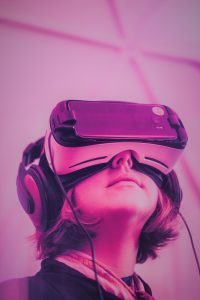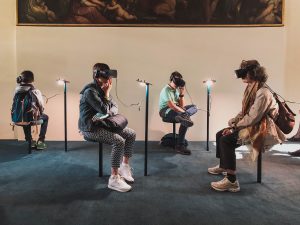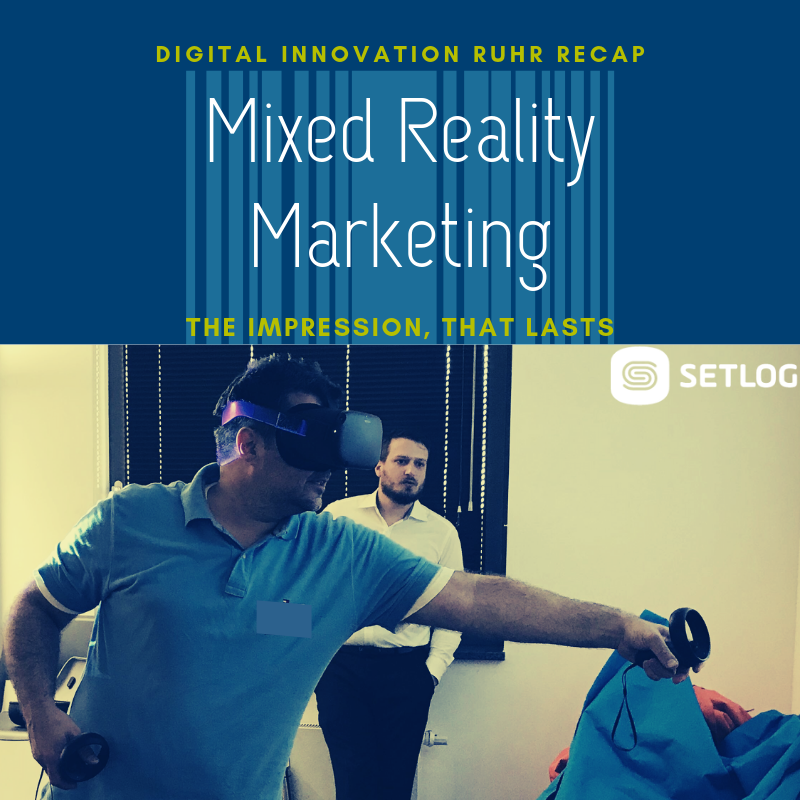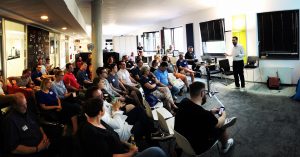The impression, that lasts
We dedicate our Meetups again and again to topics of the future, because here we find a world of new, exciting technologies and more often than not their potential is far from exhausted.
That is why, this July, at Setlog everything revolved around one of these technologies- “virtual reality”. While some only think of virtual reality as a toy, others think ahead: Mixed and virtual reality become channels for new marketing strategies. Mario-Andreas Stahl from senselab.io, who is an expert for mixed reality, showed us what that actually means and how virtual reality offers completely new possibilities to fascinate people.
Virtual reality? Augmented reality? Mixed reality???
“Virtual reality”. Most people probably have already heard of this before. But now there is Augmented and Mixed Reality, too? Isn’t that all the same? It’s not, Mario explained to us. Virtual reality means a completely virtual world in which the users can immerse themselves. This is made possible by special glasses such as the Oculus Rift or the Oculus Quest. Through these, users can look around and move in the artificially created reality. With the help of controllers, they can also interact with the world. Augmented reality, on the other hand, simply expands our actual reality. Here the users are also looking through glasses, but they see their real environment, which is supplemented by overlaid data, images or objects. Mixed reality describes a similar extension of the environment, but allows interaction as well.

I already have my reality… Do I really need another one?
What for? What does virtual reality do for me? We humans are curious, inventive, enjoy learning and regularly try out new things. In the virtual world, all this is possible, simple, fast and safe. Besides, exploring the world is fun! It’s about discovering new things, seeing miracles and experiencing situations that most people rarely get to enjoy in reality. Because of these possibilities, virtual reality has long since found its place in the gaming industry.
Virtual Reality as a marketing tool
But, isn’t all this just entertainment then? Absolutely! But this is exactly where the potential to interest people and win new customers lies. As Mario so beautifully put it: Everyone can hand out business cards at trade fairs, but what everyone can do just doesn’t stand out. A new experience in virtual reality, on the other hand, is not that easily forgotten. Mario’s customers are pursuing different businesses, so Mario is working on a diverse range of VR applications. Sometimes the objective is to help the user learn something new, sometimes it’s more about entertainment and sometimes he develops virtual replicas of machines or buildings for presentation purposes.
Thanks to a live presentation, we were able to get an idea of what this kind of presentation could look like. We were impressed to watch how one of our Meetup participants build a virtual ballpoint pen. With a big smile on his face, he put on the glasses, picked up the controllers and off he went. First, he seemed a little disoriented, but after a short time he found his way around his virtual environment quite well. And as soon as he got the hang of it, he merrily pressed the pen refill on a complex machine, installed it and finally engraved the company logo on the cover. The experience was complete when he took his glasses off and saw Mario standing in front of him holding the pen he had just made. That’s what we call a “lasting impression”! A marketing stunt like this is not easily forgotten!
Later Mario tells us that this very application will soon be offered for sale to prospective customers, with their own company logo added for engraving and freely selectable colors for the pens. We were able to see for ourselves how a VR experience can be used as an excellent marketing tool. But why does it work?
The way to a successful VR application
Marketing via Virtual Reality is quite personal. One of the biggest success factors of Virtual Reality Marketing is that it evokes positive emotions in the users. The possibility to experience something new, to interact with the world and to solve a problem on your own, leaves a joyful feeling, similar to the VR applications of the gaming industry, and therefore a positive impression remains. For the user, the experience is unconsciously more memorable than other marketing campaigns and strategies.

VR marketing also offers several advantages for the marketing department. The equipment needed to provide a VR experience is handy and easy to transport. In addition, VR marketing facilitates the follow-up of trade fair appearances. Furthermore, VR Marketing offers the possibility to present complex topics more easily and thus grants a simplified, direct access to the subject.
The successful production of a good VR application requires a number of things. If the application is implemented within a company, this is connected with the training of employees and the necessary aftercare in form of support and further development. The application itself is all about the story, the interaction possibilities and the 3D models that make up the visual units. These require a creative idea, which must be connected to the purpose of the application, a holistic concept, planning and an agile, transparent development. This can not be done on the side. How the application ultimately affects the user depends on all these factors. If the user is feeling overwhelmed, bored or unsettled, the positive effect does not occur. Mario therefore divided a successful VR experience into 5 phases: First of all, the user should be given time to arrive and enough space to immerse himself in the VR world to make himself feel comfortable. In the second phase, the user will take his first steps. While doing so, he should be able to achieve first successes quickly. Once he has completely arrived in the virtual world, it’s time to let him try what he can do with it. Now he can tinker and experiment. Finally, tension must be built up in order to round off the experience at the end, in phase 5, with the climax.
Those who pay attention to these elements can utilize an entertaining and striking VR application to better address potential customers and to give their marketing a modern touch with the impression that lasts. We were really impressed with Mario’s presentation and are looking forward to seeing more of virtual reality marketing at trade shows and companies.

